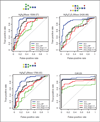Evaluation of glycomic profiling as a diagnostic biomarker for epithelial ovarian cancer
- PMID: 24557531
- PMCID: PMC4230493
- DOI: 10.1158/1055-9965.EPI-13-1073
Evaluation of glycomic profiling as a diagnostic biomarker for epithelial ovarian cancer
Abstract
Background: Prior studies suggested that glycans were differentially expressed in patients with ovarian cancer and controls. We hypothesized that glycan-based biomarkers might serve as a diagnostic test for ovarian cancer and evaluated the ability of glycans to distinguish ovarian cancer cases from matched controls.
Methods: Serum samples were obtained from the tissue-banking repository of the Gynecologic Oncology Group, and included healthy female controls (n = 100), women diagnosed with low malignant potential (LMP) tumors (n = 52), and epithelial ovarian cancers (EOC) cases (n = 147). Cases and controls were matched on age at enrollment within ±5 years. Serum samples were analyzed by glycomics analysis to detect abundance differences in glycan expression levels. A two-stage procedure was carried out for biomarker discovery and validation. Candidate classifiers of glycans that separated cases from controls were developed using a training set in the discovery phase and the classification performance of the candidate classifiers was assessed using independent test samples that were not used in discovery.
Results: The patterns of glycans showed discriminatory power for distinguishing EOC and LMP cases from controls. Candidate glycan-based biomarkers developed on a training set (sensitivity, 86% and specificity, 95.8% for distinguishing EOC from controls through leave-one-out cross-validation) confirmed their potential use as a detection test using an independent test set (sensitivity, 70% and specificity, 86.5%).
Conclusion: Formal investigations of glycan biomarkers that distinguish cases and controls show great promise for an ovarian cancer diagnostic test. Further validation of a glycan-based test for detection of ovarian cancer is warranted.
Impact: An emerging diagnostic test based on the knowledge gained from understanding the glycobiology should lead to an assay that improves sensitivity and specificity and allows for early detection of ovarian cancer.
Conflict of interest statement
No potential conflicts of interest were disclosed.
Figures



Similar articles
-
Protein-Specific Differential Glycosylation of Immunoglobulins in Serum of Ovarian Cancer Patients.J Proteome Res. 2016 Mar 4;15(3):1002-10. doi: 10.1021/acs.jproteome.5b01071. Epub 2016 Feb 24. J Proteome Res. 2016. PMID: 26813784 Free PMC article.
-
The serum glycome to discriminate between early-stage epithelial ovarian cancer and benign ovarian diseases.Dis Markers. 2014;2014:238197. doi: 10.1155/2014/238197. Epub 2014 Aug 12. Dis Markers. 2014. PMID: 25183900 Free PMC article.
-
Validation of LRG1 as a potential biomarker for detection of epithelial ovarian cancer by a blinded study.PLoS One. 2015 Mar 23;10(3):e0121112. doi: 10.1371/journal.pone.0121112. eCollection 2015. PLoS One. 2015. PMID: 25799488 Free PMC article.
-
The emerging role of HE4 in the evaluation of epithelial ovarian and endometrial carcinomas.Oncology (Williston Park). 2013 Jun;27(6):548-56. Oncology (Williston Park). 2013. PMID: 23909069 Free PMC article. Review.
-
New tumor markers: CA125 and beyond.Int J Gynecol Cancer. 2005 Nov-Dec;15 Suppl 3:274-81. doi: 10.1111/j.1525-1438.2005.00441.x. Int J Gynecol Cancer. 2005. PMID: 16343244 Review.
Cited by
-
Glycomic-Based Biomarkers for Ovarian Cancer: Advances and Challenges.Diagnostics (Basel). 2021 Apr 1;11(4):643. doi: 10.3390/diagnostics11040643. Diagnostics (Basel). 2021. PMID: 33916250 Free PMC article. Review.
-
N-linked glycan profiling in neuroblastoma cell lines.J Proteome Res. 2015 May 1;14(5):2074-81. doi: 10.1021/pr5011718. Epub 2015 Mar 16. J Proteome Res. 2015. PMID: 25730103 Free PMC article.
-
Immunoglobulin A N-glycosylation Presents Important Body Fluid-specific Variations in Lactating Mothers.Mol Cell Proteomics. 2019 Nov;18(11):2165-2177. doi: 10.1074/mcp.RA119.001648. Epub 2019 Aug 13. Mol Cell Proteomics. 2019. PMID: 31409668 Free PMC article.
-
Recent Advances in the Mass Spectrometry Methods for Glycomics and Cancer.Anal Chem. 2018 Jan 2;90(1):208-224. doi: 10.1021/acs.analchem.7b04202. Epub 2017 Oct 31. Anal Chem. 2018. PMID: 29049885 Free PMC article. Review.
-
Clinical Glycomics Employing Graphitized Carbon Liquid Chromatography-Mass Spectrometry.Chromatographia. 2015;78(5-6):307-320. doi: 10.1007/s10337-014-2813-7. Epub 2014 Dec 9. Chromatographia. 2015. PMID: 25750456 Free PMC article. Review.
References
-
- An HJ, Lebrilla CB. A glycomics approach to the discovery of potential cancer biomarkers. Methods Mol Biol. 2010;600:199–213. - PubMed
Publication types
MeSH terms
Substances
Grants and funding
LinkOut - more resources
Full Text Sources
Other Literature Sources
Medical

